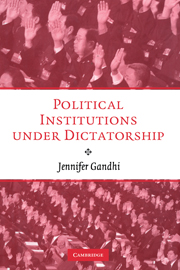Book contents
- Frontmatter
- Contents
- List of Tables and Figures
- Acknowledgments
- Introduction
- 1 The World of Dictatorial Institutions
- 2 Three Illustrative Cases
- 3 Use of Institutions to Co-opt
- 4 Institutions and Policies under Dictatorship
- 5 Institutions and Outcomes under Dictatorship
- 6 Institutions and the Survival of Dictators
- 7 Conclusion
- 8 Codebook of Variables
- Bibliography
- Author Index
- Subject Index
Introduction
Published online by Cambridge University Press: 25 July 2009
- Frontmatter
- Contents
- List of Tables and Figures
- Acknowledgments
- Introduction
- 1 The World of Dictatorial Institutions
- 2 Three Illustrative Cases
- 3 Use of Institutions to Co-opt
- 4 Institutions and Policies under Dictatorship
- 5 Institutions and Outcomes under Dictatorship
- 6 Institutions and the Survival of Dictators
- 7 Conclusion
- 8 Codebook of Variables
- Bibliography
- Author Index
- Subject Index
Summary
Why do nondemocratic rulers govern with democratic institutions, such as legislatures and political parties? One view is that these institutions under dictatorship are mere shams. Scholars and policy-makers alike have pronounced the irrelevance of formal institutions under dictatorship. In discussing the role of political institutions on regime change, Gasiorowski (1995: 883) writes: “Huntington's (1968) argument about the importance of institutionalization also applies under authoritarian regimes, but consociationalism, party system structure, electoral rules, and the type of executive system are largely irrelevant and therefore presumably have little effect.…” A USAID report (n.d.:1), in describing communist regimes in Eastern Europe and Central Asia, states more bluntly: “Elections were a sham. Parliaments had no real power. Basic democratic freedoms — free speech, the freedom to assembly and organize, the right to form independent parties did not exist.” The conclusion is clear: nominally democratic institutions constitute mere window dressing that dictators can point to as evidence of their democratic credentials.
Yet those who encourage the formation of these institutions in the interests of promoting democracy imply another view. As Jeane Kirkpatrick (1979: 37) observed: “democratic governments have come into being slowly, after extended prior experience with more limited forms of participation during which leaders have reluctantly grown accustomed to tolerating dissent and opposition.…”
- Type
- Chapter
- Information
- Political Institutions under Dictatorship , pp. xv - xxivPublisher: Cambridge University PressPrint publication year: 2008

